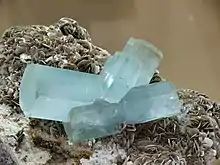| Aquamarine | |
|---|---|
| Hex triplet | #7FFFD4 |
| sRGBB (r, g, b) | (127, 255, 212) |
| HSV (h, s, v) | (160°, 50%, 100%) |
| CIELChuv (L, C, h) | (92, 60, 158°) |
| Source | X11[1] |
| ISCC–NBS descriptor | Brilliant green |
| B: Normalized to [0–255] (byte) | |
| Aquamarine (RGB) | |
|---|---|
| Hex triplet | #80FFC0 |
| sRGBB (r, g, b) | (128, 255, 192) |
| HSV (h, s, v) | (150°, 50%, 100%) |
| CIELChuv (L, C, h) | (92, 67, 147°) |
| Source | [Unsourced] |
| ISCC–NBS descriptor | Vivid green |
| B: Normalized to [0–255] (byte) | |
| Medium aquamarine | |
|---|---|
| Hex triplet | #66CDAA |
| sRGBB (r, g, b) | (102, 205, 170) |
| HSV (h, s, v) | (160°, 50%, 80%) |
| CIELChuv (L, C, h) | (76, 49, 158°) |
| Source | X11[1] |
| ISCC–NBS descriptor | Brilliant green |
| B: Normalized to [0–255] (byte) | |
Aquamarine is a color that is a light tint of teal, in between cyan and green on the color wheel. It is named after the mineral aquamarine, a gemstone mainly found in granite rocks. The first recorded use of aquamarine as a color name in English was in 1598.[2]
 Rough aquamarine
Rough aquamarine Aquamarine crystals on muscovite
Aquamarine crystals on muscovite.jpg.webp) An aquamarine brooch
An aquamarine brooch
See also
References
This article is issued from Wikipedia. The text is licensed under Creative Commons - Attribution - Sharealike. Additional terms may apply for the media files.